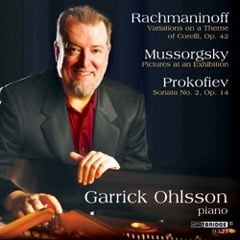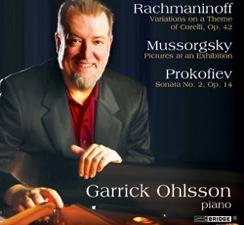
Garrick Ohlsson turned 63 just last month, but he recorded the main work on his new CD at age 26, so you can really hear the difference between a young buck and a mature artist ... not.
No, not at all. This stormy, powerful live performance in Poland of Mussorgsky’s Pictures at an Exhibition sounds very much like Ohlsson does today: a pianist with exceptionally large hands, similar to Rachmaninov’s, and effortless dynamic shifts from fff to ppp.
But first, about two current recordings:
The Rachmaninov “Corelli Variations” are relatively rarely performed, but, listening to Ohlsson’s performance on the first CD, I wonder why. With the theme’s delicate, heartfelt opening, the work creates an instant rapport with the listener.
Ohlsson plays these 20 variations (including intermezzo and coda) from the later, more classical period of the composer, with the same certitude and broad palette of colors as the young Vladimir Ashkenazy performed it many years ago. The final variation is played with an intensity that takes the breath away, the music returning to the gentle sound of the theme (not actually by Corelli, it’s an ancient tune used in his Sonata, Op. 5, No. 12).
Listen To The Music
Prokofiev: Piano Sonata No. 2, I. AllergroMussorgsky: Pictures At An Exhibition,
II. The Old Castle
Purchase Recording


A portion of each purchase helps
support San Francisco Classical Voice
The other current recording is the Prokofiev Second Piano Sonata, which has been performed and recorded by some of the great ones, from Sviatoslav Richter on. It’s a technically difficult work — which presents no problem to Ohlsson — but also a generally challenging one, to performer and listener, with its stark, percussive, dissonant, spastic chords alternating (at times coinciding in the two hands) with beautiful runs, often requiring flying speed.
Technically, Ohlsson is right up there with Richter (to compare with the best), yet he manages to produce an even more beautiful sound. The hesitating, searching theme in the opening Allegro and the hushed passages in the Andante are especially remarkable.
Pictures gets a thunderous, but never ponderous, performance from the young Ohlsson, straightforward and disciplined, though, to my ears, the recurring “Promenade” theme seems fast enough for marching, especially at the beginning, not so much for the ambling usually employed in museums.
The “Gnome” movement is properly grotesque and a bit scary. “The Old Castle” is Ohlsson at his best, broadly singing, beautifully played. “Unhatched Chickens” cluck embryonically. “Market Place at Limoges,” taken at the appropriate breakneck space, is performed so clearly that every note is heard, none lost — unlike the no-transition jump into “Catacombs” (which may be an engineering glitch). “Great Gate of Kiev” is majestic, orchestral. Here’s a young pianist with a career I am willing to bet on, even without the certainty of hindsight.

